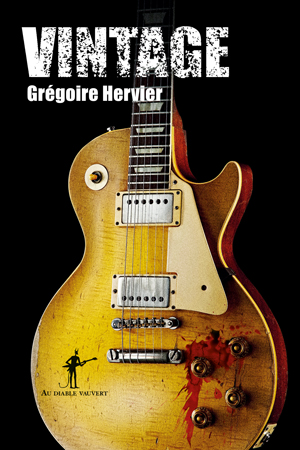
Why should a review of a French mystery novel about electric guitars appear on the Anglophone website of an accordionist/bassist? In a general sense, the recent French novel “Vintage” by Grégoire Hervier artfully conveys what can be hard for a musician to express: how somewhere there may be that unique instrument that feels right in your hands and responds to your musical thoughts.
In “Vintage”, 26-year-old Thomas embarks on a wild quest for a Gibson Moderne, a mythical electric guitar that may or may not have existed. Thomas, erstwhile guitarist in a French rock band and occasional music journalist, is filling in at a Parisian vintage guitar shop when the owner sends him to personally deliver a rare Gibson Les Paul guitar to a new client living on the shores of Loch Ness. Thomas arrives with guitar in hand only to discover that the mysterious client is a Scottish Lord residing in Boleskine House. Past residents of this manor include Aleister Crowley and Jimmy Page, and this intersection of the dark arts with popular music vis-à-vis the electric guitar effectively establishes the novel’s atmosphere.
After delivering the Les Paul guitar, Thomas is invited to see the mysterious Lord’s collection of vintage guitars, culminating in a private room for displaying several extremely rare Gibson guitars from 1957: a Flying V and an Explorer/Voyager. A third guitar is apparently missing, and Thomas learns that the Lord was recently robbed of the guitar completing this Gibson ‘Modernistic’ triptych: the Moderne, a guitar so rare that there is no evidence that it ever made it beyond the prototype stage (with the exception of a short-lived reissue in the 1980s). Despite this, the enigmatic occupant of Boleskine House must prove its existence for insurance purposes, something that even he is incapable of doing since he never took any photographs. The Lord, confined to a wheelchair, convinces Thomas to collect any information that could possibly be used to establish the guitar’s existence, in exchange for a share of the insurance settlement. And so begins Thomas’s adventure of a lifetime: chasing down leads from Loch Ness to Australia, ultimately crisscrossing the same American routes and cities known for generations by itinerant bluesmen: Memphis, Chicago, New Orleans, and inevitably … the devil’s crossroads (Highways 49 and 61) in Clarksdale, MS.
Without providing too many plot details, Thomas’s quest for the Holy Grail of vintage guitars puts him in contact with an Elvis impersonator, as well as a young PhD student from Ole Miss. These supporting characters are ‘instrumental’ in narrowing his search to a 45 RPM released by a cursed bluesman in the late 1950s. But will Thomas be able to assemble enough evidence to satisfy his end of the bargain?
Throughout this ‘road novel’, Grégoire Hervier introduces the reader to many interesting side trips. I particularly enjoyed learning about Pierre Schaeffer and his manipulated recordings (e.g. “sillon fermé”), or the use of ‘sound on sound’ techniques and ring modulator effects. Likewise, I was unaware that the current trend of “relic-ed” guitars can be traced to Keith Richards and his need for a back-up copy of his famed Telecaster, Micawber. Personally, I found this particular anecdote to embody a subtle but recurring theme in “Vintage” that really resonated with me. Whereas on the surface the Micawber replica could be seen as a simple economic solution to gigging with a priceless vintage guitar, it also suggests a deeper meaning – is the instrument priceless for its rarity on the vintage market, or because the musician has a unique bond with this one instrument?
What does it mean to bond with a special instrument? Perhaps part of the equation has something to do with a ‘familiarity of touch’, facilitating the transfer of a personal musical language to the instrument. The great jazz accordionist Richard Galliano speaks of returning to his beloved Victoria accordion from his youth, after experiment with Cavagnolo accordions in the 1970s-80s; since the 1990s this instrument has not left his side as he travels and earns accolades throughout the world. Oddly, my personal adventure with the accordion began with a fictive yet familiar sensation. After a period of extensive listening to bandoneonist Astor Piazzolla I awoke one morning feeling as though I had played the accordion, in which I experienced this familiarity of touch – the keys and bellows all seemed to work in harmony – despite never having played accordion before! This dream felt so genuine that I became consumed with the idea of playing accordion, setting off a cascade of events that has sent me in search of that instrument to bond with, from learning the piano accordion to changing course with the chromatic button accordion, and eventually seeking out my current instrument in Castelfidardo, the cradle of Italian accordions. Have I found that one instrument? Perhaps, but this does not mean that the adventure should end here!
Have you found that one instrument that is quintessential to your art? I would like to read your comments!
“Vintage” by Grégoire Hervier was published in 2016 by “Au Diable Vauvert”, and can be found everywhere. With an engaging storyline, it is the fastest that I have ever read a novel in French (and it is the only French novel that I have read twice). It may be worth learning French just to read this novel!
